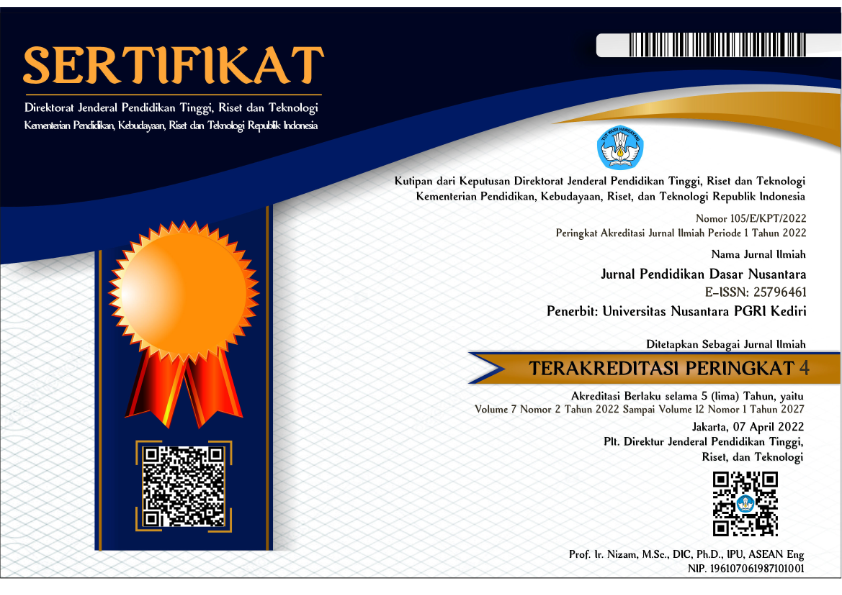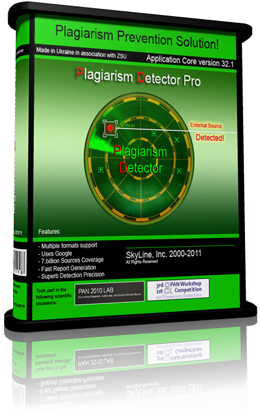PENGGUNAAN INTELLIGENT MIND MAPPING UNTUK MENINGKATKAN PROSES DAN HASIL BELAJAR IPA SISWA KELAS V DI SDN PURWANTORO 3 KECAMATAN BLIMBING KOTA MALANG
DOI:
https://doi.org/10.29407/jpdn.v2i1.340Abstract
Abstract: The study science learning with the use of intelligent mind mapping aims to describe: (1) measures the use emindmaps on mind mapping on the course from science to students in class V SDN Purwantoro 3 Blimbing district of Malang. (2) improvement of processes and student learning outcomes in class V SDN Purwantoro 3 Blimbing district Malang Malang on science lesson through the use emindmaps on mind mapping. The design of the study is a reference to the model cycle classroom action research by Kemmis and Taggart includes four stages: (1) planning, (2) action, (3) observation, and (4) reflection. Scene of this research is in SDN Purwantoro 3 Blimbing district of Malang. Data collection techniques using observation, assessment techniques of students' work, technical questionnaire, attitudinal scales, interview, test, documentation, and field notes. The results showed using intelligent on mind mapping, learning outcomes of students has increased. The increase in the average value of students' work on the pre-action to the first cycle increased from 46.55 into 70.69 and the second cycle into 80.25. Final test results also increased. The average value of final test results from pre-action to the first cycle increased from 45.80 at 70.75 and the second cycle to 89.70. Increased activity of students from pre-action to the first cycle increased from 47.75 into 80.15 and the second cycle increased to 89.15. The increase in the average value of student attitudes scale results from pre-action to the first cycle of 18.15 into 26.15 (from low to high) and the second cycle increased to 36.20 (from higher to very high). The conclusion of this study is the use of intelligent mind mapping can improve the process and results of students of class V SDN Purwantoro 3 on science learning
Keywords: intelligent mind mapping, learning process, learning result, elementary school science learning.
Abstrak: Penelitian pembelajaran IPA dengan penggunaan intelligent mind mapping ini bertujuan untuk mendeskripsikan: (1) langkah-langkah penggunaan emindmaps pada mind mapping pada matapelajaran IPA untuk siswa kelas V di SDN Purwantoro 3 Kecamatan Blimbing Kota Malang. (2) peningkatan proses dan hasil belajar siswa kelas V di SDN Purwantoro 3 Malang Kecamatan Blimbing Kota Malang pada matapelajaran IPA melalui penggunaan emindmaps pada mind mapping. Rancangan penelitian yang digunakan adalah PTK mengacu pada model siklus PTK oleh Kemmis dan Taggart meliputi empat tahap yaitu (1) perencanaan, (2) pelaksanaan tindakan, (3) pengamatan, dan (4) refleksi. Kancah dari penelitian ini yaitu di SDN Purwantoro 3 Kecamatan Blimbing Kota Malang. Teknik pengumpulan data menggunakan teknik observasi, teknik penilaian hasil karya siswa, teknik angket, skala sikap, wawancara, tes, dokumentasi, dan catatan lapangan. Hasil penelitian menunjukkan dengan menggunakan intelligent pada mind mapping, hasil belajar siswa mengalami peningkatan. Peningkatan nilai rata-rata hasil karya siswa pada pra tindakan ke siklus I mengalami peningkatan dari 46,55 menjadi 70,69 dan pada siklus II menjadi 80,25. Hasil tes akhir juga mengalami peningkatan. Nilai rata-rata hasil tes akhir dari pra tindakan ke siklus I mengalami peningkatan dari 45,80 menjadi 70,75 dan pada siklus II menjadi 89,70. Peningkatan aktivitas siswa dari pra tindakan ke siklus I mengalami peningkatan dari 47,75 menjadi 80,15 dan pada siklus II meningkat menjadi 89,15. Peningkatan nilai rata-rata hasil skala sikap siswa dari pra tindakan ke siklus I dari 18,15 menjadi 26,15 (dari rendah menjadi tinggi) dan pada siklus II meningkat menjadi 36,20 (dari tinggi menjadi sangat tinggi). Kesimpulan penelitian ini yaitu penggunaan intelligent mind mapping dapat meningkatkan proses dan hasil belajar siswa kelas V SDN Purwantoro 3 pada matapelajaran IPA.
Kata kunci: Intelligent Emindmaps Mind Mapping, Proses Belajar, Hasil Belajar, Pembelajaran IPA SD
Downloads
Downloads
Published
Issue
Section
License
Authors who publish with this journal agree to the following terms:
- Copyright on any article is retained by the author(s).
- The author grants the journal, the right of first publication with the work simultaneously licensed under a Creative Commons Attribution License that allows others to share the work with an acknowledgment of the work’s authorship and initial publication in this journal.
- Authors are able to enter into separate, additional contractual arrangements for the non-exclusive distribution of the journal’s published version of the work (e.g., post it to an institutional repository or publish it in a book), with an acknowledgment of its initial publication in this journal.
- Authors are permitted and encouraged to post their work online (e.g., in institutional repositories or on their website) prior to and during the submission process, as it can lead to productive exchanges, as well as earlier and greater citation of published work.
- The article and any associated published material is distributed under the Creative Commons Attribution-ShareAlike 4.0 International License

































